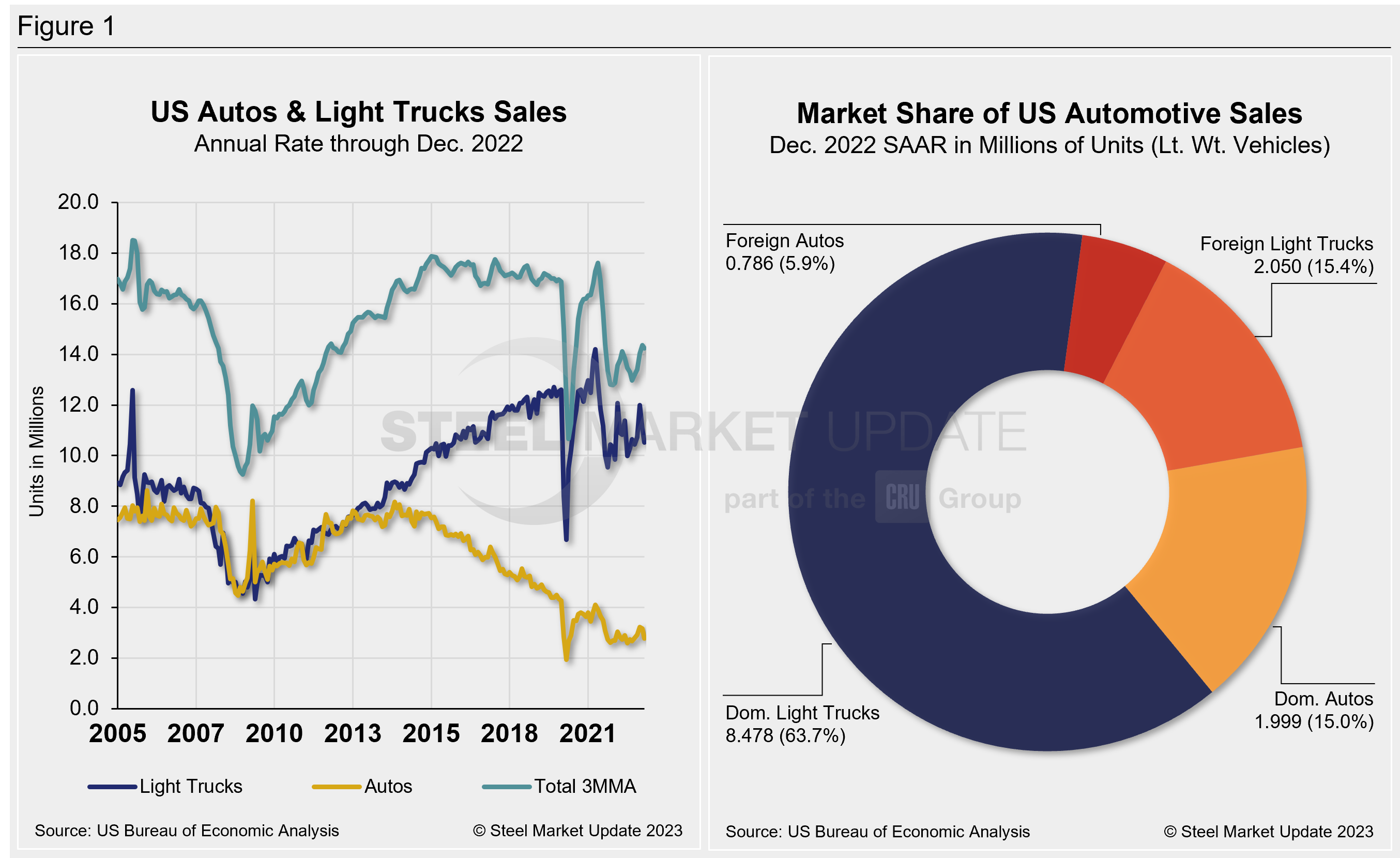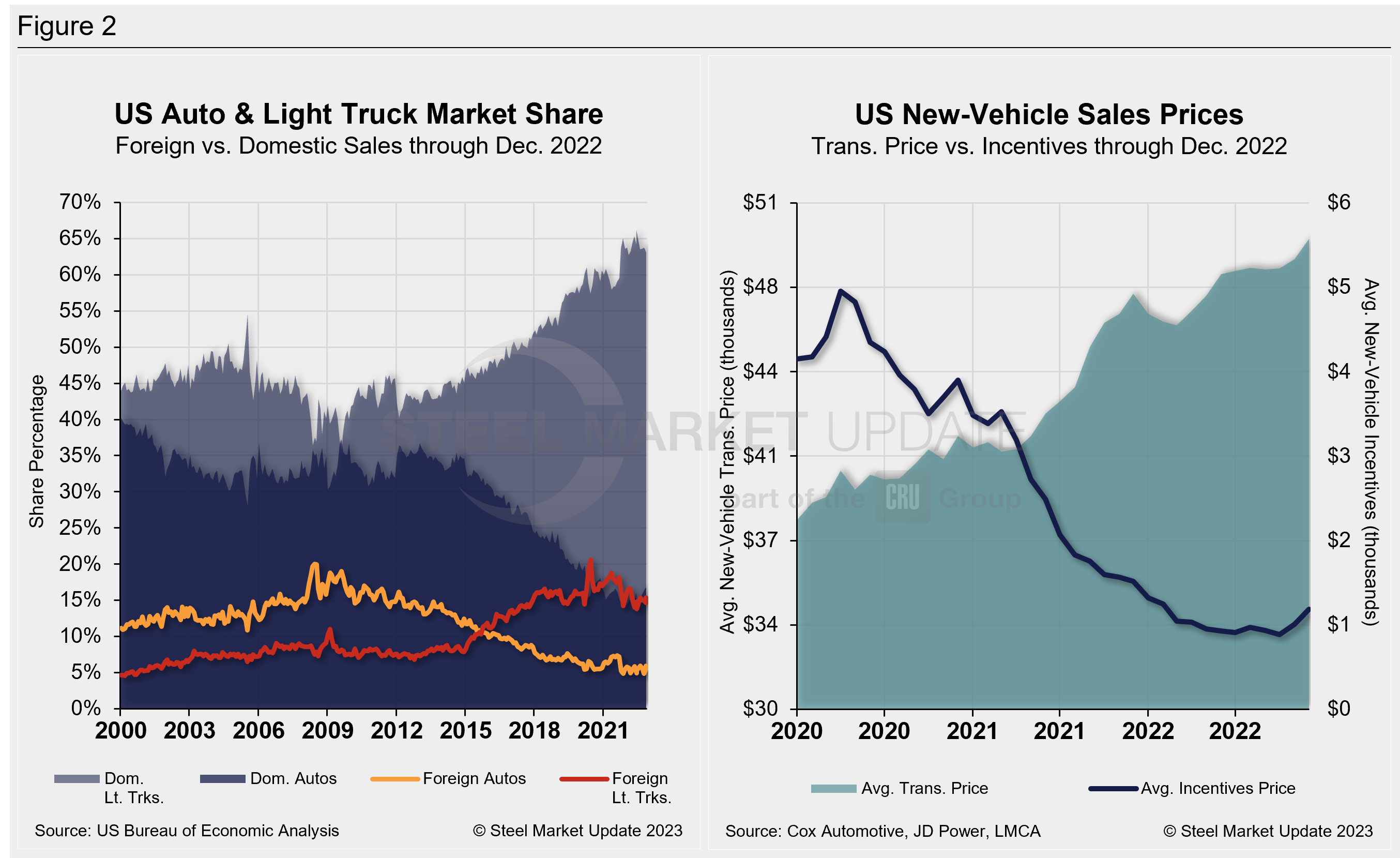Trade Cases
US Light Vehicle Sales Ease Again in December
Written by David Schollaert
January 18, 2023
US light-vehicle (LV) sales slowed further in December, with an unadjusted figure of 1.26 million units, the US Bureau of Economic Analysis (BEA) reported. Despite the month-on-month (MoM) decline, last month’s total was still 4.9% higher year on year (YoY), and the fifth consecutive month to see YoY increases in sales. Prior to August 2022, YoY sales gains had not been seen since July 2021.
LV sales were down 6.3% MoM in December, slipping to an annualized 13.3 million units. This was slightly above the consensus forecast that expected a larger decline to 13.0 million.
After rising to a nine-month high in October, vehicle sales have now declined repeatedly through December. Last month’s sales ended the year with some deterioration, falling back to an annualized level not seen since last summer. Data suggests the late December winter storm had some impact on last month’s soft reading. The harsh winter weather across much of the US kept buyers away over the holiday shopping season.
All told, sales averaged just 13.7 million units for the year – the lowest annual tally since 2011.
Both passenger vehicles (-12.0% MoM) and light-trucks (-4.8% MoM) registered declines. Light-trucks accounted for 81% of last month’s sales, down roughly a percentage point from December 2021.
Below in Figure 1 is the long-term picture of sales of autos and lightweight trucks in the US from 2005 through December 2022. Additionally, it includes the market share sales breakdown of December’s 13.3 million vehicles at a seasonally adjusted annual rate.

The new-vehicle average transaction price (ATP) was $49,507 in December, up from $48,681 in November, and setting a new all-time high. ATPs were 1.7% higher (+$826) in December vs. the prior month and 4.8% (+$2,264) above the year-ago period, according to Cox Automotive data.
Incentives increased again for the second straight month. Last month’s incentives were $1,187 in December, up from $1,009 in November. With the MoM recovery, incentives were back above the $1,000 mark for the second time in eight months and roughly 2.4% of the average transaction price. Incentives are down 21.7%, or $329 YoY.
In December, the annualized selling rate of light trucks was 10.529 million units, down 4.8% vs. the prior month but still 6.8% better YoY. Auto annualized selling rates saw similar dynamics over the same periods: down 11.8% but up 3.7%, respectively.
Figure 2 details the US auto and light-truck market share since 2010 and the divergence between average transaction prices and incentives in the US market since 2020.

Canadian light vehicle sales were estimated to have increased by 7% YoY, to 107.000 units in December, according to LMC Automotive data. The selling rate is thought to have slowed to 1.5 million units annually, from a downwardly revised 1.6 million units annually in November. Total annual sales were just 1.5 million units, down by 8% YoY, and the lowest since 2009.
Mexican light vehicle sales were up by 20% YoY in December to 120,000 units. For the calendar year, sales grew by a healthy 8% YoY, to 1.1 million units.
Editor’s Note: This report is based on data from the US Bureau of Economic Analysis (BEA), LMC Automotive, JD Power, and Cox Automotive for automotive sales in the US, Canada, and Mexico. Specifically, the report describes light vehicle sales in the US.
By David Schollaert, David@SteelMarketUpdate.com

David Schollaert
Read more from David SchollaertLatest in Trade Cases

Steel groups welcome passage of budget bill
Steel trade groups praised the passage of the Big Beautiful Bill (BBB) in Congress on Thursday.

Canada moves to curb steel imports with TRQs
Canada has implemented tariff-rate quotas (TRQs) on steel imports to help stabilize its domestic market.

Commerce launches probe into unfairly traded rebar imports
Here are the details and a case timeline for the rebar trade case recently initiated by the Commerce Department.

Leibowitz on Trade: Who is winning the tariff debate?
Most economists will tell you that universal tariffs will result in inflation and reduce demand, causing a recession or worse. (After all, this is what happened in the 1930s). It is a rare product that is so essential that demand will not go down if prices go up.

Canadian steel industry fears thousands of job losses from US tariffs
The Canadian steel industry is bracing for thousands of job losses because of US tariffs, the Canadian Steel Producers Association says.
